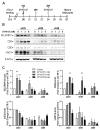Selenium-Binding Protein 1 (SELENBP1) Supports Hydrogen Sulfide Biosynthesis and Adipogenesis
- PMID: 33673622
- PMCID: PMC7997437
- DOI: 10.3390/antiox10030361
Selenium-Binding Protein 1 (SELENBP1) Supports Hydrogen Sulfide Biosynthesis and Adipogenesis
Abstract
Hydrogen sulfide (H2S), a mammalian gasotransmitter, is involved in the regulation of a variety of fundamental processes including intracellular signaling, cellular bioenergetics, cell proliferation, and cell differentiation. Cystathionine g-lyase (CSE), cystathionine b-synthase (CBS), and 3-mercaptopyruvate sulfurtransferase (3-MST) are currently considered the three principal mammalian H2S-generating enzymes. However, recently, a fourth H2S-producing enzyme, selenium-binding-protein 1 (SELENBP1), has also been identified. The cellular regulatory role(s) of SELENBP1 are incompletely understood. The current study investigated whether SELENBP1 plays a role in the regulation of adipocyte differentiation in vitro. 3T3-L1 preadipocytes with or without SELENBP1 knock-down were subjected to differentiation-inducing conditions, and H2S production, cellular lipid accumulation, cell proliferation, and mitochondrial activity were quantified. Adipocyte differentiation was associated with an upregulation of H2S biosynthesis. SELENBP1 silencing decreased cellular H2S levels, suppressed the expression of the three "classical" H2S-producing enzymes (CBS, CSE, and 3-MST) and significantly suppressed adipocyte differentiation. Treatment of SELENBP1 knock-down cells with the H2S donor GYY4137 partially restored lipid accumulation, increased cellular H2S levels, and exerted a bell-shaped effect on cellular bioenergetics (enhancement at 1 and 3 mM, and inhibition at 6 mM). We conclude that SELENBP1 in adipocytes (1) contributes to H2S biosynthesis and (2) acts as an endogenous stimulator of adipocyte differentiation.
Keywords: fat; gasotransmitters, mitochondria, differentiation, metabolism; obesity.
Conflict of interest statement
The authors declare no conflict of interest.
Figures










Similar articles
-
Inhibition of the 3-mercaptopyruvate sulfurtransferase-hydrogen sulfide system promotes cellular lipid accumulation.Geroscience. 2022 Aug;44(4):2271-2289. doi: 10.1007/s11357-022-00600-9. Epub 2022 Jun 10. Geroscience. 2022. PMID: 35680713 Free PMC article.
-
Mechanism of cystathionine-β-synthase inhibition by disulfiram: The role of bis(N,N-diethyldithiocarbamate)-copper(II).Biochem Pharmacol. 2020 Dec;182:114267. doi: 10.1016/j.bcp.2020.114267. Epub 2020 Oct 7. Biochem Pharmacol. 2020. PMID: 33035509
-
Altered Capacity for H2S Production during the Spontaneous Differentiation of Caco-2 Cells to Colonocytes Due to Reciprocal Regulation of CBS and SELENBP1.Antioxidants (Basel). 2022 Sep 30;11(10):1957. doi: 10.3390/antiox11101957. Antioxidants (Basel). 2022. PMID: 36290680 Free PMC article.
-
Potential role of the 3-mercaptopyruvate sulfurtransferase (3-MST)-hydrogen sulfide (H2S) pathway in cancer cells.Pharmacol Res. 2020 Apr;154:104083. doi: 10.1016/j.phrs.2018.11.034. Epub 2018 Nov 27. Pharmacol Res. 2020. PMID: 30500457 Review.
-
Hydrogen Sulfide, an Endogenous Stimulator of Mitochondrial Function in Cancer Cells.Cells. 2021 Jan 22;10(2):220. doi: 10.3390/cells10020220. Cells. 2021. PMID: 33499368 Free PMC article. Review.
Cited by
-
Role of 3-mercaptopyruvate sulfurtransferase in cancer: Molecular mechanisms and therapeutic perspectives.Transl Oncol. 2025 Feb;52:102272. doi: 10.1016/j.tranon.2025.102272. Epub 2025 Jan 14. Transl Oncol. 2025. PMID: 39813769 Free PMC article. Review.
-
The Impact of H2S on Obesity-Associated Metabolic Disturbances.Antioxidants (Basel). 2021 Apr 21;10(5):633. doi: 10.3390/antiox10050633. Antioxidants (Basel). 2021. PMID: 33919190 Free PMC article. Review.
-
Identification of candidate biomarkers and pathways associated with type 1 diabetes mellitus using bioinformatics analysis.Sci Rep. 2022 Jun 1;12(1):9157. doi: 10.1038/s41598-022-13291-1. Sci Rep. 2022. PMID: 35650387 Free PMC article.
-
Integration of ATAC-Seq and RNA-Seq Reveals VDR-SELENBP1 Axis Promotes Adipogenesis of Porcine Intramuscular Preadipocytes.Int J Mol Sci. 2024 Nov 22;25(23):12528. doi: 10.3390/ijms252312528. Int J Mol Sci. 2024. PMID: 39684239 Free PMC article.
-
Methanethiol: A Scent Mark of Dysregulated Sulfur Metabolism in Cancer.Antioxidants (Basel). 2023 Sep 19;12(9):1780. doi: 10.3390/antiox12091780. Antioxidants (Basel). 2023. PMID: 37760083 Free PMC article. Review.
References
Grants and funding
LinkOut - more resources
Full Text Sources
Other Literature Sources
Research Materials

